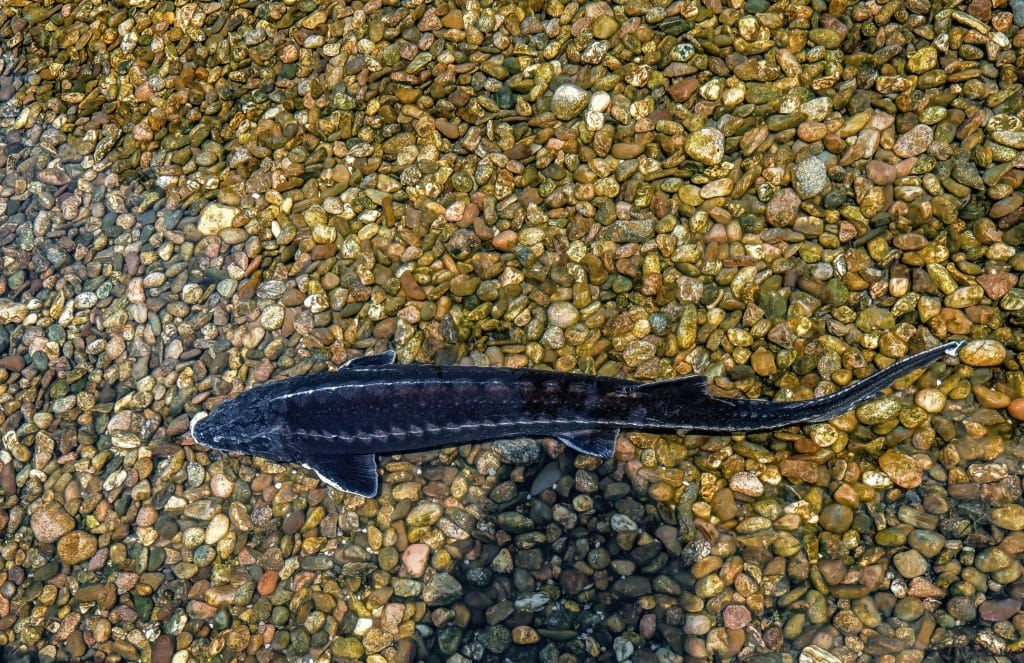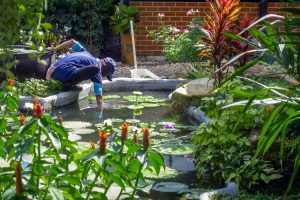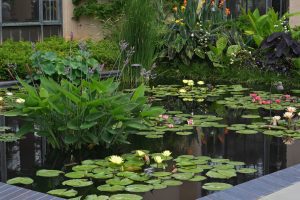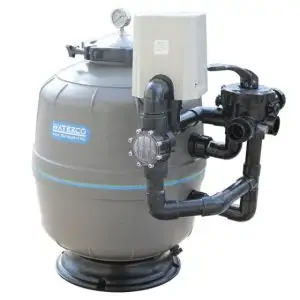
Discover essential tips for Sterlet fish care in your garden pond. Keep your fish healthy and thriving with our expert advice!
Sterlet fish, a unique species of sturgeon, can make fascinating additions to garden ponds. These prehistoric-looking creatures bring a touch of the ancient to modern water features.
Sterlets need a pond of at least 2,000 gallons and 3 feet deep to thrive, with clean, well-oxygenated water.

Sterlets are covered in bony plates called scutes instead of scales, giving them a distinctive appearance. They’re bottom feeders, using their extended snouts to search for food in the pond substrate.
While they grow more slowly than some pond fish, sterlets can eventually reach impressive sizes.
Proper care is essential for sterlets to flourish in a garden pond setting. This includes maintaining suitable water conditions, providing appropriate nutrition, and ensuring enough space as they grow.
With the right setup and attention, these remarkable fish can become long-lived, captivating residents of your garden pond.
Key Takeaways
- Sterlets require large, deep ponds with excellent water quality to thrive
- These unique fish have special dietary needs as bottom-feeders
- Proper care can result in sterlets becoming long-term, eye-catching pond inhabitants
Understanding the Sterlet (Acipenser Ruthenus)
The Sterlet is a unique freshwater fish species with fascinating physical traits and specific habitat requirements. This small sturgeon adapts well to pond environments when properly cared for.
Physical Characteristics
Sterlets are the smallest sturgeon species, typically reaching up to 90 cm in length. They have a distinctive elongated body shape with a flattened snout and protruding mouth.
Their bodies are covered in bony plates called scutes, arranged in five rows:
- Dorsal scutes along the back
- Two rows of lateral scutes on each side
- Ventral scutes on the underside
Sterlets come in various colours, including:
- Grey
- Olive-brown
- Albino (white with pink eyes)
Their barbels, located near the mouth, help them locate food on the pond bottom.
Natural Habitat and Behaviour
Sterlets are naturally found in large rivers across Eurasia, including the Danube and Volga. They are potamodromous, meaning they migrate within freshwater systems.
In the wild, Sterlets prefer:
- Cool water temperatures (10-18°C)
- High oxygen levels
- Sandy or gravelly river bottoms
These fish are bottom-feeders, using their sensory barbels to find food like:
- Small invertebrates
- Insect larvae
- Plant matter
Sterlets are generally peaceful and can coexist with other pond fish. They are active during cooler parts of the day and often rest on the bottom.
Setting Up Your Garden Pond for Sterlets

Proper pond setup is crucial for the health and well-being of sterlets. A suitable environment requires careful consideration of size, filtration, and water parameters to ensure these unique fish thrive.
Pond Size and Volume
Sterlets need ample space to swim and grow. A garden pond for sterlets should be at least 3 metres long and 1.5 metres deep. This size allows for proper swimming and helps maintain stable water conditions.
The pond volume is equally important. Aim for a minimum of 2,000 litres per sterlet. This generous water volume helps dilute waste and maintain water quality.
Remember, sterlets can grow quite large. A mature sterlet may reach 70-100 cm in length. Plan your pond with their adult size in mind to avoid future issues.
Filtration Systems
Effective filtration is essential for keeping sterlet ponds clean and healthy. A robust system should include both mechanical and biological filtration.
Mechanical filters remove solid waste and debris. Use a pre-filter or skimmer to catch large particles before they enter the main filtration system.
Biological filtration is crucial for breaking down harmful ammonia and nitrites. Consider using a moving bed filter or large external canister filter for this purpose.
Aim to turn over the entire pond volume through the filter at least once every two hours. This frequent circulation helps maintain water quality and oxygen levels.
Water Quality Parameters
Sterlets are sensitive to water conditions. Regular testing and maintenance of key parameters is vital for their health.
pH: Keep the pH between 7.0 and 8.0. Sterlets prefer slightly alkaline water.
Temperature: Maintain water temperature between 10°C and 20°C. Avoid rapid temperature changes.
Dissolved oxygen: Sterlets require high oxygen levels. Use aerators or waterfalls to increase oxygen content, especially in warmer months.
Ammonia and nitrites: These should always be at 0 ppm. Any detectable levels can be harmful to sterlets.
Nitrates: Keep below 40 ppm through regular water changes and proper filtration.
Test water parameters weekly and adjust as needed to provide a stable environment for your sterlets.
Sterlet Nutrition and Feeding

Sterlets need a specific diet to thrive in garden ponds. Proper nutrition and feeding practices are crucial for their health and growth. Let’s explore their dietary requirements, feeding routines, and suitable food types.
Dietary Needs
Sterlets are carnivores that require specialised sinking foods. Their diet should be high in protein, particularly from fish and shrimp meal. These bottom-feeders need easily digestible food to support their unique digestive system.
Key nutritional components for sterlets include:
- High protein content (40-45%)
- Moderate fat levels (15-20%)
- Low carbohydrate content
- Essential vitamins and minerals
It’s important to choose food specifically formulated for sturgeon or sterlets. These specialised diets ensure proper growth and maintain the fish’s overall health.
Feeding Routines
Establishing a consistent feeding routine is essential for sterlets. They prefer to feed at the bottom of the pond, so it’s crucial to use sinking pellets or other foods that reach the pond floor.
Feeding tips:
- Feed 2-3 times daily in small amounts
- Remove uneaten food after 10-15 minutes
- Adjust feeding frequency based on water temperature
- Feed other pond fish first to keep them occupied
During colder months, reduce feeding frequency as sterlets’ metabolism slows down. In summer, increase feeding to support higher activity levels.
Types of Sturgeon Food
Several food options are suitable for sterlets in garden ponds. The best choice is specialist sinking foods formulated for sturgeon or sterlets.
Common sturgeon food types:
- Sinking pellets: These are the most popular and convenient option.
- Freeze-dried foods: Bloodworms or krill can be occasional treats.
- Fresh foods: Small pieces of fish or shrimp can supplement their diet.
Look for foods with a typical analysis of:
- 44% minimum protein
- 20% oil
- 8.5% ash
- 1.7% fibre
Quality sturgeon food also contains vitamins A, C, D3, and E. These nutrients support the sterlet’s immune system and overall health.
Sterlet Health and Welfare

Keeping sterlets healthy in a garden pond requires careful monitoring and prompt action when issues arise. Proper care ensures these unique fish thrive in their environment.
Signs of a Healthy Sterlet
Healthy sterlets display active behaviour and a good appetite. They swim smoothly and stay near the bottom of the pond. Their skin should be free from marks or lesions.
Sturgeon-specific foods are vital for their well-being. A sterlet eagerly taking food is a positive sign.
Clear eyes and intact barbels indicate good health. The fish’s body should be symmetrical without any swelling or deformities.
Regular observation helps spot potential problems early. Healthy sterlets often group together, showing social behaviour.
Common Health Issues
Sterlets can face several health challenges in pond environments. Poor water quality is a primary concern, leading to stress and weakened immunity.
Fungal infections may appear as cotton-like growths on the skin. Bacterial infections can cause skin ulcers or fin rot.
Changes in behaviour often signal health issues. Look out for:
- Reduced appetite
- Excessive hiding
- Unusual swimming patterns
- Gasping at the surface
Parasites like ich can cause white spots on the skin. Internal parasites may lead to weight loss and lethargy.
Injuries from pond hazards or aggressive tankmates can also occur. Always check for physical damage.
Medications and Treatments
When treating sterlets, it’s crucial to use medications safe for sturgeons. Many common fish treatments can harm these sensitive creatures.
For bacterial infections, sturgeon-safe antibiotics are available. Follow dosage instructions carefully to avoid over-medication.
Salt baths can help with external parasites and minor skin issues. Use aquarium salt at a concentration of 1-3 grams per litre for short periods.
Improving water quality is often the best treatment:
- Regular water changes
- Proper filtration
- Balanced diet
For fungal infections, anti-fungal medications designed for pond use are effective. Always remove carbon from filters during treatment.
In severe cases, consult a vet experienced with sturgeon care. They may prescribe specialised treatments or suggest quarantine measures.
Co-Habitation with Other Pond Fish
Sterlets can live peacefully with many pond fish species, but careful selection is key. Proper management helps prevent stress and aggression among pond inhabitants.
Compatible Species
Sterlets get on well with koi and goldfish. These common pond fish are good mates for sterlets. Tench are another good choice, as they share the sterlet’s bottom-feeding habits.
Golden orfe can also be good companions. They swim in the upper water layers, leaving sterlets to roam the bottom. This reduces competition for space and food.
Avoid keeping sterlets with very small fish. Sterlets might eat them by mistake. Large, aggressive fish are also not suitable tankmates.
Avoiding Aggression and Stress
Sterlets are peaceful fish, but they need space. A crowded pond can lead to stress and fights. Make sure the pond is big enough for all fish.
Feed fish regularly to prevent hunger-related aggression. Offer small, frequent meals rather than one big feed.
Provide hiding spots like plants or rock caves. These give fish places to retreat if they feel stressed.
Keep water quality high. Clean water helps reduce stress for all pond fish. Regular water changes and good filtration are vital.
Monitor fish behaviour. If you see signs of stress or aggression, act quickly to solve the problem.
Breeding Sterlets in Garden Ponds
Breeding sterlets in garden ponds requires careful planning and specific conditions. Sexual maturity and proper breeding environments are key factors for success.
Sexual Maturity and Reproduction
Sterlets reach sexual maturity at different ages based on gender. Males typically mature at 3-5 years old, while females take 5-8 years. These slow-growing fish need time to develop fully before breeding.
Reproduction occurs in spring when water temperatures rise. Female sterlets can lay up to 100,000 eggs, which males then fertilise externally. The eggs stick to plants or the pond bottom and hatch after 3-7 days.
Breeding sterlets is challenging in garden ponds. Natural spawning rarely happens due to the specific conditions required. Artificial breeding methods may be more successful for pond owners wanting to reproduce these fish.
Breeding Conditions
Sterlets need precise conditions to breed successfully. Water temperature is crucial, ideally between 10-15°C during spawning season. The pond should have:
- A large surface area (at least 1000 gallons)
- Good water quality with low ammonia and nitrite levels
- Strong filtration and water movement
- Plenty of oxygen
- Gravel or sandy substrate for egg adhesion
Specialised diets high in protein are essential before and during breeding season. This helps the fish develop healthy eggs and sperm.
Creating a separate breeding area in the pond can improve chances of success. This should mimic natural river conditions with a current and suitable spawning substrate.
Understanding Water Conditions
Sterlets require specific water conditions to thrive in garden ponds. Proper temperature, oxygen levels, and algae management are crucial for their health and well-being.
Temperature and Oxygen Levels
Sterlets prefer cooler water temperatures. The ideal range is between 10-22°C. In summer, it’s important to monitor the pond temperature closely. If it rises above 22°C, consider adding shade or increasing water flow to cool the pond.
Oxygen levels are critical for sterlets. These fish need high oxygen levels to survive. Cold water holds more oxygen, which is beneficial for sterlets.
To maintain proper oxygen levels:
- Use a pond pump to create surface agitation
- Install a waterfall or fountain
- Add aquatic plants that produce oxygen
In winter, keep part of the pond surface open to allow gas exchange. This can be done using a de-icer or pond heater.
Managing Algae and Blanketweed
Algae and blanketweed can pose serious risks to sterlets. Blanketweed can suffocate small sturgeons, making its management essential.
To control algae and blanketweed:
- Use an ultraviolet clarifier to maintain clear water
- Remove excess algae manually with a net or rake
- Introduce beneficial bacteria to compete with algae for nutrients
- Add floating plants to provide shade and reduce sunlight
Be cautious when using algaecides, as some can be harmful to sterlets. Always check product labels and consult a pond specialist before adding any chemicals to your pond.
Regular water testing is vital. Maintain ammonia at 0.0mg/l, nitrite below 0.25 mg/l, and nitrate below 150 mg/l. Keep pH levels between 7.0 and 9.0 for optimal sterlet health.
Special Considerations for Unique Sterlet Varieties
Some Sterlet varieties require extra care and attention. These special types have unique needs that pond owners should be aware of to ensure their health and wellbeing.
Albino Sterlets
Albino Sterlets are a striking white variety of the standard Sterlet. They lack pigmentation, making them more sensitive to sunlight. Pond owners should provide ample shaded areas to protect these fish from excessive UV exposure.
Albino Sterlets also need pristine water quality. They are more susceptible to stress and disease, so regular water testing is crucial. Aim for optimal pH levels between 7.0 and 8.0.
These fish may require special diets rich in vitamins and minerals to compensate for their genetic differences. Offer a varied diet of high-quality pellets and live foods to ensure proper nutrition.
Hybrid Sturgeons
Hybrid sturgeons are crosses between different sturgeon species, often involving Sterlets. These fish can have unique care requirements based on their genetic makeup.
Some hybrids grow larger than pure Sterlets, so pond size is a key factor. Ensure your pond is at least 5 times the length of the fish to allow for proper growth and movement.
Hybrid vigour can result in faster growth rates. Monitor food intake carefully to prevent overfeeding and maintain good water quality.
Water temperature preferences may vary depending on the hybrid’s parentage. Research the specific hybrid’s needs and adjust pond conditions accordingly.
Maintaining Water Flow and Aeration
Proper water circulation and aeration are vital for a healthy sterlet pond. These processes ensure oxygen reaches all areas and remove harmful gases. Let’s explore the importance of water movement and effective aeration methods.
Importance of Water Circulation
Good water flow keeps sterlet ponds healthy. It moves oxygen-rich water throughout the pond. This helps sterlets breathe easier.
Water circulation also:
- Prevents stagnant areas
- Reduces algae growth
- Distributes heat evenly
- Removes waste gases like carbon dioxide
Garden ponds need extra care in summer. Warm water holds less oxygen. Add fresh water regularly to maintain levels. Use dechlorinated water to protect fish and plants.
Aeration Techniques and Equipment
Aeration adds oxygen to pond water. This is crucial for sterlets, especially in warm weather. There are several ways to aerate a pond:
Air pumps: These are popular and effective. They push air through tubes into the water.
Fountains: They look nice and add oxygen as water splashes.
Waterfalls: Create a natural-looking oxygen boost.
Air stones: These create tiny bubbles that dissolve into the water.
Pond air pumps are often used with air stones or discs. These spread air throughout the pond. In summer, use multiple aeration devices. This ensures sterlets have enough oxygen to thrive.
Comparing Sterlets with Other Sturgeon
Sterlets differ from other sturgeon species in size, habitat preferences, and care requirements. These differences impact how they’re kept in garden ponds.
Sterlets Versus Larger Sturgeon Varieties
Sterlets are smaller than many other sturgeon species. They typically grow to 36 inches (90 cm) in length, making them more suitable for garden ponds. Larger sturgeon varieties can reach impressive sizes.
Diamond sturgeon, for example, can grow over five feet long in ponds. The largest sturgeon species, like the Beluga, can reach extraordinary lengths in the wild.
Sterlets have less demanding space requirements than larger sturgeons. A pond for sterlets should be at least 3.85 times their body length. This means a 2.7-metre pond could potentially house a mature sterlet.
Larger sturgeons need much more space. They’re often not practical for most garden ponds due to their size.
Brackish Water Species
Unlike some sturgeon species that thrive in brackish water, sterlets are freshwater fish. They’re well-suited to garden ponds without added salt.
Brackish water sturgeons, such as the Atlantic and Gulf sturgeons, require a mix of fresh and saltwater. These species aren’t suitable for standard garden ponds.
Sterlets are more adaptable to varying water conditions than brackish species. They can tolerate a wider range of temperatures and pH levels.
Sterlets prefer shade and deeper areas of the pond. They’re less likely to bask in shallow, sunny spots compared to some other pond fish.
Future Considerations for the Esteemed Sterlet
Sterlets require careful planning for their long-term care and can impact the pond ecosystem. These factors are crucial for ensuring the fish’s health and the balance of the aquatic environment.
Long-Term Care Planning
Sterlets can live for many decades, so planning for their future is essential. These fish can grow up to 70cm in length, which means pond size is a key consideration.
As sterlets age, their needs may change. Regular health checks become more important to catch any issues early. Their diet might need adjusting to suit their changing metabolism.
Water quality becomes even more critical as sterlets grow larger. Improved filtration systems may be necessary to handle the increased waste production.
Owners should also consider the fish’s social needs. Sterlets are social creatures and may benefit from companionship as they age.
Impact on Ecosystem
Introducing sterlets to a garden pond can significantly affect the existing ecosystem.
These carnivorous fish may prey on smaller pond inhabitants.
Their feeding habits can alter the pond’s nutrient balance.
This might lead to changes in water quality and plant growth.
Regular water testing becomes crucial to maintain a healthy environment.
Sterlets’ bottom-feeding behaviour can stir up sediment, potentially affecting water clarity.
This might require adjustments to filtration or pond design.
On the positive side, sterlets can help control certain pest populations.
Their presence may also create a more diverse and interesting pond ecosystem.
Related Posts
- All about Pond Bead Filters: Understanding Their Benefits and Usage
- Understanding the Pond Nitrogen Cycle: Its Significance for Fish Health and Ecosystem Balance
- What Are Pond Skimmers And How Do You Choose The Right One? Essential Guide for Clear Water Maintenance
- What You Need to Know About Pond Filtration
- What are Marginal Pond Plants? Understanding Their Role and Benefits in Aquatic Ecosystems
- Oase BioTec ScreenMatic² Filter: The Ultimate Solution for Efficient Pond Filtration
- How to Repot Pond Plants: A Step-by-Step Guide for Thriving Water Gardens
- Pricing for Pond Cleaning: Understanding Costs and Services



